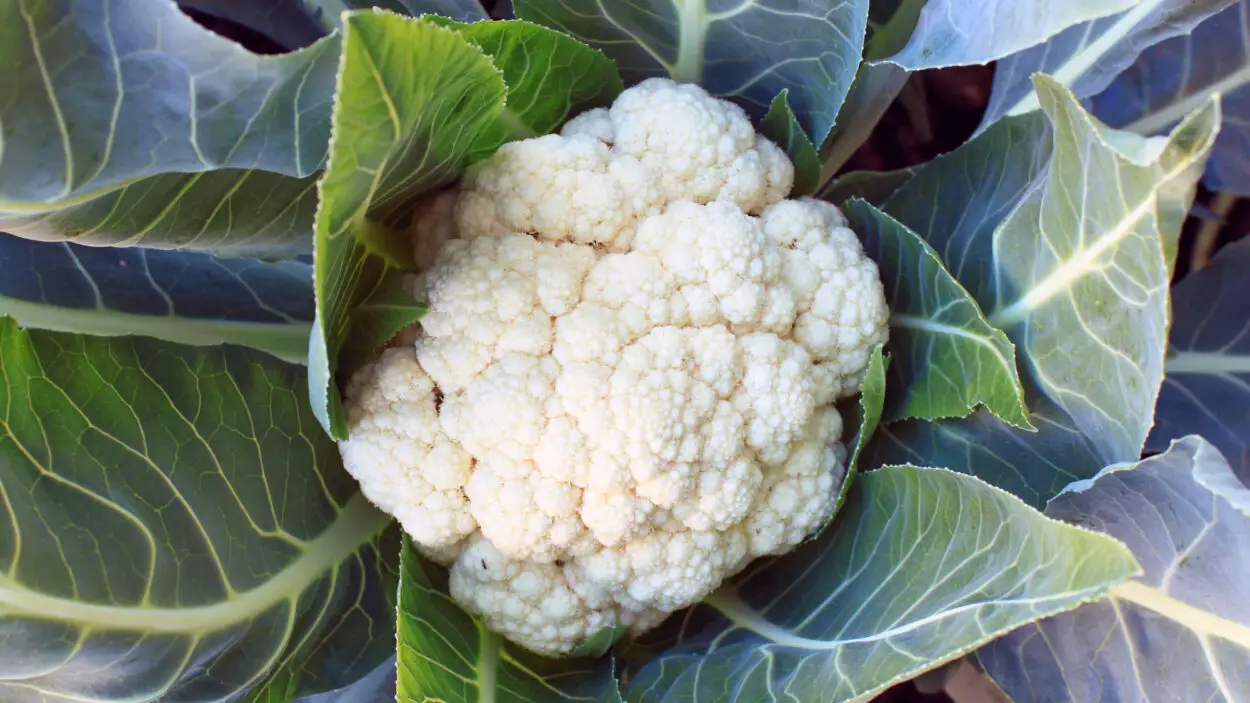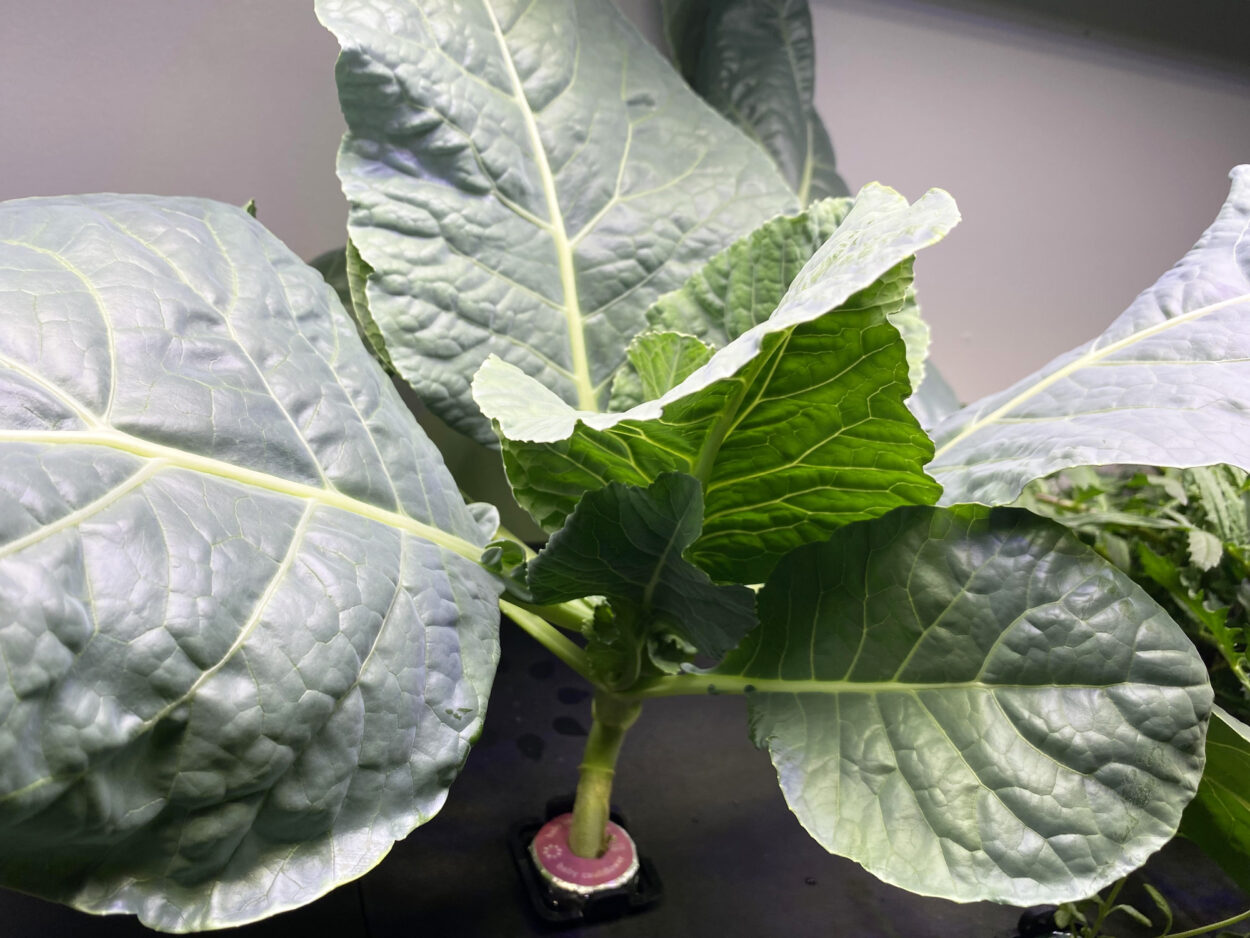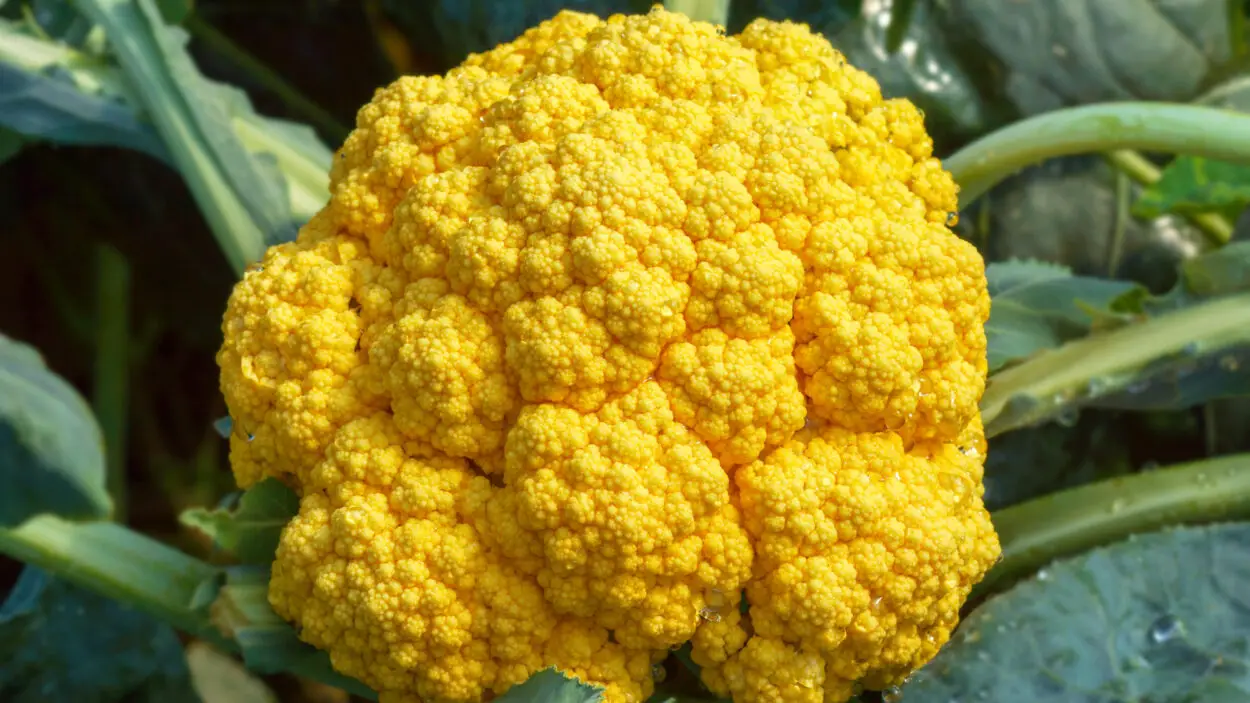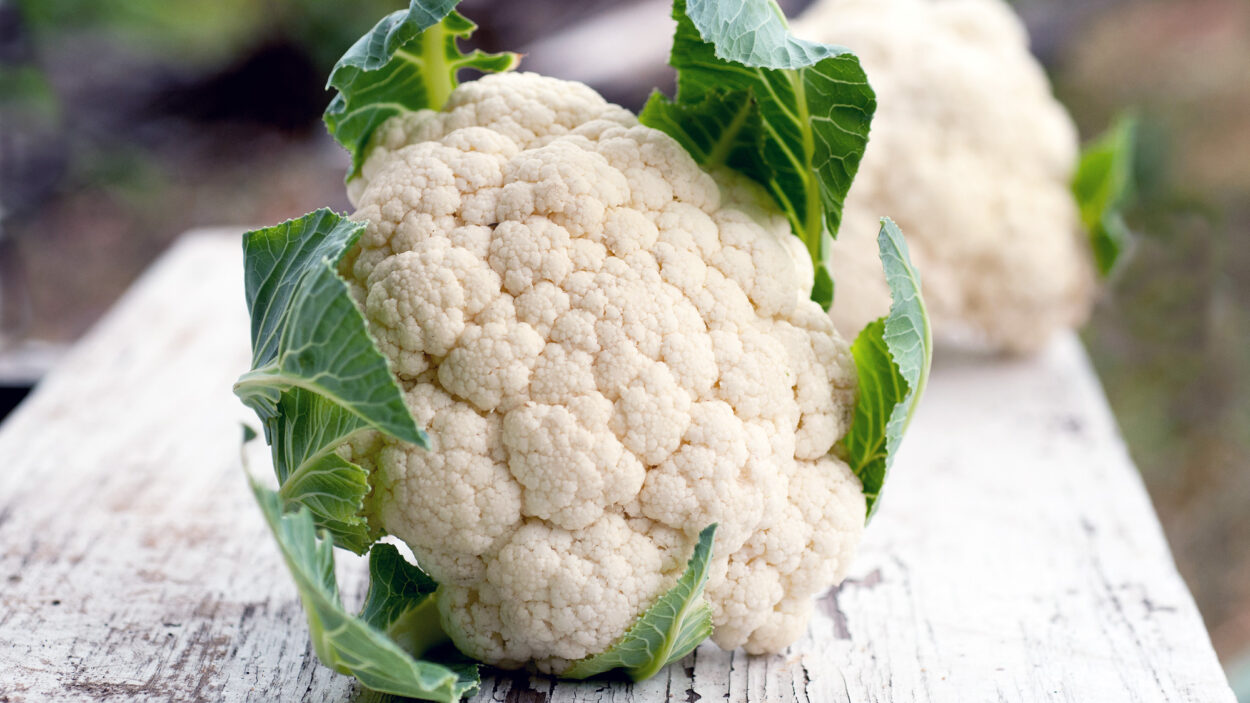The Secret To Growing Hydroponic Cauliflower: A Complete Guide To Growing the Best Cauliflower Indoors

This post follows our research editorial guidelines.

Have you ever wondered how to cultivate the crispiest, tastiest cauliflower right in the comfort of your own home? I had the same question! The answer lies in hydroponic gardening.

Given their preference for a Goldilocks climate – not too hot, not too cold, but just right – cauliflowers flourish in consistent temperatures between 55 and 70°F, basking in about six hours of direct sunlight. Too hot, and the head matures improperly. Too cold, and you have a bolting cauliflower on your hands.
In this guide, I’ll walk you through the steps to growing hydroponic cauliflower indoors.
Table of Contents
Can You Grow Hydroponic Cauliflower?
Yes, you can grow hydroponic cauliflower. Hydroponic cultivation refers to the process of growing plants without soil, typically in a nutrient-rich water solution. Cauliflower, being a versatile and adaptable crop, can definitely be grown in a hydroponic system.
However, it is worth noting that cauliflower is a relatively challenging plant to grow compared to other vegetables due to its specific requirements. Therefore, it’s better suited for gardeners who have some experience with hydroponics.
You see, the magic of growing cauliflower hydroponically isn’t just about the thrill of cultivation, but also about the reward of harvesting a fresh, homegrown vegetable right from your indoor garden.
It’s a journey that combines a bit of science with a pinch of patience, ultimately culminating in a crunchy, nutrient-rich bite of your own creation.
As you hover over your hydroponic system, meticulously checking pH levels, adjusting light sources, and tenderly caring for your cauliflower plants, you become more than just a grower.
You’re an urban farmer, an indoor botanist, and a sustainable food enthusiast, all in one. Just remember, while cauliflower may be a bit of a diva in the hydroponic world, the taste of your hard-earned, home-grown veggie is certainly worth the extra effort.
How Long Does It Take To Grow Cauliflower Hydroponically?
Growing cauliflower hydroponically can significantly reduce the growth cycle compared to traditional soil cultivation, typically taking around 8 to 12 weeks from seed to harvest. The exact timeline depends on several factors like the variety chosen, temperature, light conditions, and the specific nutrient balance in your system.
Varieties of cauliflower can differ substantially in their maturity period. For example, the ‘Snow Crown’ variety often matures in as little as 50 days, while others, like ‘Amazing’, require closer to 75 days.
Temperature is another vital factor influencing the growth rate of hydroponic cauliflower. The optimal temperature range for most cauliflower varieties is between 10-20°C (50-68°F). Too warm or too cold temperatures can stress the plants, potentially slowing their growth or causing abnormalities in the heads.
Keep in mind that successful hydroponic cultivation requires consistent monitoring and adjustments to maintain optimal conditions. But with these conditions met, you’ll definitely have an efficient system that yields faster and potentially more abundant cauliflower crops than traditional gardening.

Best Cauliflower Varieties For Hydroponics
Cauliflowers come in many varieties, but the type you want to grow hydroponically will depend on factors like personal preference, growth span, conditions, etc. Here are the best cauliflower varieties ideal for hydroponics:
Type 1: Snow Crown
Snow Crown is one of the most popular cauliflower varieties for hydroponics due to its adaptability and relatively quick maturity time. The plant typically matures in just 50 to 60 days, making it an excellent choice for growers seeking a rapid turnaround.
Snow Crown cauliflowers are known for their large, firm, and snowy-white heads that can reach up to 8 inches in diameter. This variety’s adaptability allows it to thrive in a range of temperatures, though it prefers a cool environment between 10°C to 20°C.
Snow Crown also shows good resistance to diseases that typically affect cauliflower, like fusarium wilt and black rot, making it an ideal choice for beginners.
Type 2: Amazing
Amazing is a relatively newer variety of cauliflower, but it has gained popularity mainly due to its size. It matures in about 68 to 75 days, offering a medium to large-sized head that is firm and crisp.
Amazing is renowned for its uniformity and consistency in growth, making it highly suitable for hydroponic systems.
Although it performs best in temperatures between 15°C to 20°C, it can tolerate slight deviations and still produce robust, healthy heads.
Type 3: Cheddar

The Cheddar cauliflower variety is unique, not just for its vibrant orange hue but also for its nutrient-rich composition. It gets its name from its orange-colored heads, which are indicative of its high beta-carotene content. Beta-carotene is a form of vitamin A that can be beneficial for vision and immune function.
Cheddar cauliflowers mature in about 60 to 70 days, producing large, dense heads that retain their rich color even after cooking. This feature adds visual appeal and nutritional value to various dishes, making it a preferred choice for many home cooks and professional chefs.
How to Grow Hydroponic Cauliflower
Starting from seed to the harvest of lush, tasty cauliflower heads, hydroponic gardening is a science and an art. When executed well, it allows us to enjoy cauliflower’s nutritional benefits without dealing with soil-related issues and weather constraints. Let us learn how!
Step 1: Germination
Start by choosing quality seeds from reliable suppliers, ensuring you opt for a variety suited to hydroponics, like the “Snow Crown” or “Amazing”. Now, the medium for germination is crucial. Rockwool cubes are an excellent choice due to their great water retention and breathability, providing ideal conditions for seeds to germinate.
Before planting the seeds, pre-soak the rockwool cubes in pH balanced water (around pH 6.0) for at least two hours. This ensures optimal conditions for germination. When planting the seeds, make sure you place only one or two seeds per cube to avoid overcrowding. Cover them with a small amount of the medium at 20-22 C to provide a dark environment, which seeds love for germination.
Use a heat mat if necessary, especially in cooler climates. Within 4-10 days, the first signs of life—tiny green sprouts—should appear.
Step 2: Light
After the emergence of seedlings, they enter the phototrophic phase, meaning they require light to grow. In the early stages, seedlings need 10-12 hours of light daily. Fluorescent lights or LED grow lights are your best friends here, as they provide the full spectrum of light your young plants need, without the heat that can potentially harm them.
Keep the lights close to the seedlings—about 4-6 inches away—but not touching, to prevent burning the delicate sprouts. A handy hack is to use adjustable light fixtures that can be raised as the plant grows.
Step 3: Growing medium
The moment your seedlings display at least two sets of true leaves—those that resemble the mature plant’s foliage—it’s time to transport them to your hydroponic system.
The medium should possess excellent water retention properties, yet allow for good airflow. Expanded clay pellets, also known as Hydroton, and coco coir are outstanding choices for cauliflower.
Tip: Ensure that the medium is damp, not soaking, during transplantation. Too much water can suffocate the roots, causing root rot. Use a pair of clean tweezers to handle seedlings during the transplantation to minimize potential damage.
Step 4: Water Ph and EC
A pH range of 6.0-6.5 is ideal as it allows for maximum nutrient absorption. Outside this range, nutrients may become unavailable, leading to nutrient deficiencies. A simple digital pH meter can help you maintain this balance.
Moving on, the EC, will measure the total dissolved salts or nutrients. For cauliflower, an EC level of around 2.2-2.5 mS/cm is optimal. It’s essential to check EC levels regularly as anything too high or too low can hinder plant growth.
Step 5: Nutrients
Hydroponic cauliflower, like all plants, needs a balanced nutrient solution for robust growth and bountiful yield. The primary nutrients are Nitrogen (N), Phosphorus (P), and Potassium (K), collectively referred to as N-P-K.
In the early vegetative stage, focus on Nitrogen as it’s essential for leafy growth. Once the plant starts forming heads, slightly increase the Phosphorus and Potassium levels. Use a balanced liquid fertilizer during the growth stage and transition to a lower nitrogen fertilizer with a higher amount of prosperous.
Step 6: Spacing
Proper spacing is essential for cauliflower, which can spread to a large size. Allocate at least 15-20 inches of space between plants. Spacing is important not just for growth, but it also influences light penetration and air circulation, both of which contribute to plant health and productivity.
Step 7: Support
Cauliflower plants, especially when bearing the weight of their hefty heads, can become top-heavy and tend to lean or even topple. Providing support is therefore crucial. Garden stakes, trellises, or even string attached to the top of your grow tent can help keep your plants upright and prevent potential damage.

Step 8: Pests
Pests can pose a significant challenge even in hydroponics. Aphids, whiteflies, and cabbage worms are some common culprits. Employing organic pest control measures such as neem oil can combat these unwelcome visitors.
Additionally, introducing beneficial insects like ladybugs and lacewings can provide a biological solution to pest problems.
Step 9: Disease
Cauliflower is susceptible to fungal diseases like downy mildew and bacterial soft rot. Keeping humidity levels under control, ensuring ample air circulation, and conducting regular plant check-ups for early signs of disease can go a long way in disease prevention. Isolate or remove diseased plants quickly to prevent the spread.
Remember,
“In gardening, as in life, forewarned is forearmed. Regularly scouting your plants for early signs of trouble makes all the difference between disease prevention and disaster management,”
Professor Jennifer Bousselot, an expert in controlled environment agriculture
Types of Hydroponics to Grow Cauliflower In
Here are some hydroponic systems best-suited to grow cauliflower:
Aquaponic
The symbiotic system of Aquaponics involves the cultivation of plants and fish in a mutual environment. The fish provide organic waste that’s converted into nutrients by beneficial bacteria, providing nourishment for the cauliflower plants. The plants, in turn, filter and clean the water for the fish.
Aeroponic
With Aeroponics plants are suspended in air, and nutrients are delivered via a fine mist to the exposed roots. This method allows for excellent oxygenation, promoting faster growth and potentially higher yields.
Deep Water Culture
Deep Water Culture is a popular choice for many hydroponic gardeners due to its simplicity and efficiency. In this system, the plants’ roots are submerged in a nutrient-rich oxygenated solution. DWC systems often include air stones or diffusers to keep the water oxygenated.
FAQs
Is it Better to Grow Cauliflower In Water or Soil?
Soil gardening has its charm, especially for those who love the feel of earth between their fingers. But for city-dwellers with limited space, or those seeking a more controlled environment for their plants, hydroponics can be a game changer.
Will Hydroponic Cauliflower Bolt?
In case you’re wondering, bolting is when plants prematurely go into flowering mode, often leading to a bitter taste. This happens mainly due to high temperatures or stress. Even though your cauliflower is chilling in its hydroponic setup, it’s not completely safe from bolting. It’s less likely, but still possible.
Can I Grow Cauliflower In My Tower Garden?
Sure, you can! Tower gardens are a type of vertical hydroponic system, and they’re fantastic space savers. Your cauliflower will absolutely love it there, as long as you give it enough space to grow. Remember, these plants aren’t the tiniest, so plan your tower garden accordingly.
Final Thoughts
So that was my wrap on the secret to growing hydroponic cauliflower. Whether you’re an indoor gardening enthusiast or just a cauliflower lover, the joy of harvesting your own home-grown, hydroponic cauliflower is quite unmatched. So, gather your seeds, set up your system, and let the green journey begin!

Before you go!
11 of the best flowers to grow in hydroponics
How to grow hydroponic herbs indoors: Beginners guide to growing fresh herbs at home
7 Best Hydroponic Grow Lights for a Successful Indoor Garden
How To Grow The Best Hydroponic Tomatoes: From Seed to Savory